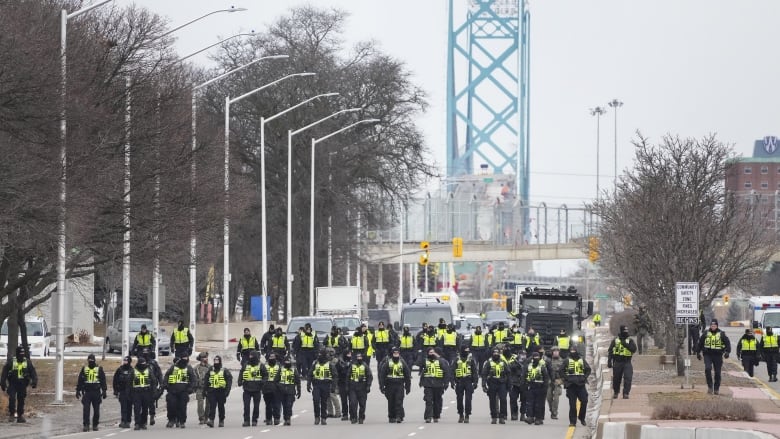Windsor police considering creating a new unit to deal with large protests: internal document
The Freedom Convoy/Ambassador bridge blockade debrief document is an exhibit in the Emergency Act Inquiry

The Windsor Police Service(WPS) examined the idea of creating a Public Order Unit to help control large crowds of people in the wake of the Ambassador Bridge blockade, according to a debriefing document submitted to the Emergencies Act Inquiry in Ottawa.
It also shedslight on what Windsor policebelieves it was lacking during the blockade earlier this year and what it could do to improve its response if there was another large protest.
The Ambassador Bridge blockadebegan on Feb. 7 as a protest against vaccination mandates. People and vehiclesblockedtraffic from crossing the U.S.-Canada border holding up what some say is billions of dollars in trade.
- Clearing Ambassador Bridge blockade quickly would have 'inflamed' protesters: police chief
- Ambassador Bridge blockade a priority, but Windsor police refused initial offers for help: OPP
The Windsor protestisplaying a role in the public hearings that havebeen taking place in Ottawa that are examining the federal government's firstever use of the emergencies act to deal withprotests in Ottawa and protests at other border crossings.
-
Have a question or something to say? Email: ask@cbc.ca or join us live in the comments now.
However, the Ambassador Bridge protestwas dispersed by police on Feb.13, a day before Ottawa invoked the act to declare a public order emergency.
Initial response
In the document,the WPS says its patrol was completely outnumbered and it was evident the that the crowd wanted a confrontation. One communication included in the document included a report of truck drivers "getting out of their trucks and walking [North bound] with tire irons in their hands."
"Plans were put in place to have additional police personnel from other services to attend," it read.
Some of the issues the report pointed out were:
- There was no specific plan in place when bridge was first shut down
- Only a fraction of officers remained to take service calls while a majority maintained points on Huron Church Road.
- Patrol personnel were totally burned out
- Overtime became an immediate concern
- Officers questioned why we waited so long to act on injunction
Public Order Unit
One of the questions the debrief asks is whether WPS should develop a Public Order Unit or POU.
POUs are units that are responsible for managing large crowds of people.
Right now Windsor police relies on OPP or other municipal police services to provide POUs.
The cost to start up such a unit would be $300,000 according to a presentation given to senior administration a couple of months after the blockade.

The report points out funding for training and equipment recently made available through the provincial government that includes an investment of $96 million dollarsthat would support "province-wide responses during unlawful demonstrations and illegal blockades that impede international borders and airports."
Other improvements
The debrief lays out both successes and areas where improvements are needed based on what unfolded at the protest.
It said its arrest plan could have been made earlier and and that the plan of towing and seizingvehicles should have been distributed.
The template used for arrests was not sufficient, according to the document and that information could have been provided to the arresting officers about the different charges that were applicable.
"A process needs to be in place to deal with mass arrests," the report read.
"A large number of arrests at the same time caused significant delay in booking each individual in cells. It also inhibited the interviewing of any of the arrested parties."
"The arresting officers need to [be] cognizant that they must articulate their respective arrests, accordingly."
The Windsor police service will be called to testify before the hearing this month.












_(720p).jpg)


 OFFICIAL HD MUSIC VIDEO.jpg)
.jpg)



























































































